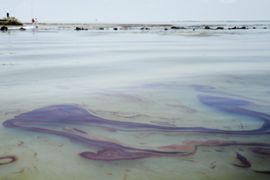BP confident of oil cap success
Oil giant hopeful that leak has been stemmed, but tests being extended to allay concerns.

“We’re feeling more comfortable that we have integrity,” Kent Wells, BP’s senior vice-president of exploration and production, said on Saturday.
“The longer this test goes, the more confidence we have,” he said, saying there was always the provision that tests could be extended.
Pressure questions
Al Jazeera’s John Terrett, reporting from New Orleans, said that although the oil giant was upbeat that the cap was working, the slow rising pressure did not fit their original predictions of what would happen when the well was capped.
| in depth | |
|
“The pressure is not as high as they expected it to be,” Terrett said.
“There are two reasons why this might be – one is that there could be a leak somewhere, the other is that the well is so depleted, with all the oil having gushed out, that it doesn’t have the energy that they thought it would have at this stage.
“BP is talking now about maybe not reconnecting the siphoning devices to the ships on the surface, but letting the oil stay within the system until they are ready to finally concrete the well over sometime in the middle of August.”
Wells said pressure had reached 6,745 pounds per square inch [psi] and was rising about two psi per hour.
US authorities and BP want the pressure to hit and sustain at 7,500 psi or more, which would indicate all the oil and gas was flowing to the top with no leaks.
Increased pressure would indicate the well could hold back all the oil flow if ships siphoning off the crude had to disconnect and move away in advance of a hurricane.
Pressure beneath 6,000 psi would indicate a possible leak.
Well capped
On Thursday, BP closed the vents on the new, 75-tonne tight-fitting metal cap and finally stopped crude from spewing into the Gulf of Mexico for the first time since the April 20 oil rig explosion.
| In video |
|
One fisherman’s oil spill tragedy |
Experts say between 35,000-60,000 barrels of oil have been pouring into the Gulf of Mexico daily for about 13 weeks, threatening vulnerable wildlife and fouling the shores of five US Gulf states.
Barack Obama, the US president – who has seen his approval ratings drop as the crisis has dragged on – warned on Friday that more work was needed before the well could be considered fixed.
“We won’t be done until we actually know that we’ve killed the well and that we have a permanent solution in place,” Obama said at the White House.
The cap is designed to prevent oil from spilling into the Gulf, either by keeping it bottled up in the well, or by capturing it and piping it to ships on the surface.
It is not yet clear which way the cap will be used if it passes the pressure test.
Either way, the cap is a temporary measure until a relief well can be completed and mud and cement can be pumped into the broken well deep underground to seal it more securely than the cap.
The first of the two relief wells being drilled could be done by late July or August.
